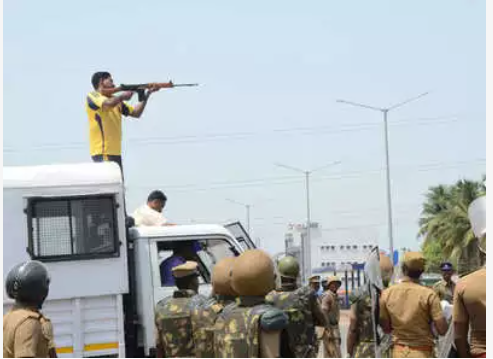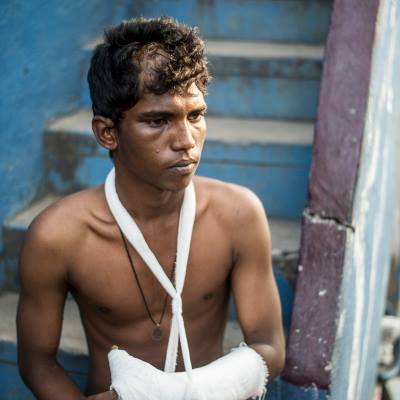Bobby Kunhu
“Charles Darwin is wrong: only the closest to the Government will survive” – Ljupka Cvetanova
On 18th October, 2022, two reports were tabled before the Tamil Nadu State Assembly, the first report by a Commission of Inquiry headed by Retd. Justice A. Arumaghaswamy looked into the circumstances under which former 68-year-old Chief Minister, J. Jayalalithaa of Tamil Nadu died on 5th December, 2016. Nobody is doubting the veracity of her ill health and the fact that she was hospitalized consequent to the same. What the Commission inquired into was probable malfeasant lapses that could have led to her demise and having found the basis for such lapses, recommended a full-fledged probe.
The second report was of the Commission of Inquiry headed by Retd. Justice Aruna Jagadeesan that examined the 22nd May 2013 police violence against people protesting the expansion of a copper smelting plant owned by Sterlite Corporation, where 13 people aged between 15 and 62 were killed in cold blood for exercising a Constitutional fundamental right and injured 104 more.
It is perplexing that while the latter report was presented to the government of Tamil Nadu on 14th May, 2022 and the former on 27th August, 2022 – the government decided to table both on the same day. Predictably, mainstream media and discourse will give priority to the natural death of a 68-year-old woman, where there were at best malfeasance by caregivers, negligence, misleading information and bad decision making as against the brutal gunning down of a crowd that killed 13 and injured 104 people. This should be a relief for Vedanta, the parent company of Sterlite, whose operations globally are being questioned on their complicity in human rights abuses. Because with the more glamorous death of Jayalalithaa hogging the limelight, there is bound to be lesser focus on the role played by Vedanta in the precipitation of the violence directly and/or indirectly.
The grouse of the protestors in Thoothukudi was not against the state, but against indiscriminate corporate colonisation of Thoothukudi by Vedanta and how agents of the state were complicit in the same. The standoff in Thoothukudi was essentially to do with Vedanta’s need to expand its copper smelting operations and lack of other physical sites for the same. Here, it may be useful to go back into a bit of Vedanta’s history in Thoothukudi;
“While Vedanta has multiple metal interests, and has been accused of large scale breach of law, human rights and environmental norms in almost all its operations, here it will be sufficient to go through its copper history because the Thoothukudi massacre is a direct result of Vedanta’s copper interests. Vedanta’s search for a site to locate a copper smelting plant in India started in the early 90s. After unsuccessful scouting initially, the company was given 500 acres of land in the scenic coastal town of Ratnagiri for setting up a 60000 tonne copper smelter and associated facilities. But this attempt came a cropper with a strong peoples’ movement backed by indictment of a court appointed expert committee headed by environmentalist Rashmi Mayur that forced the Government of Maharashtra to order the company to diversify into a non-polluting venture or vacate. Given that the heat in Ratnagiri was making it too difficult for Vedanta, they pulled out and moved into Thoothukudi in Tamil Nadu in 1994, where they were welcomed with open arms by the then government of the state. While both the major political parties in Tamil Nadu vied with each other in making Sterlite cosy and comfortable – the foundation stone of the plant having been laid by Jayalalithaa of the AIADMK and the plant commissioned by her arch rival Karunanidhi of the DMK. This along with the clout that the company enjoyed with rival union governments that have been in power since the 90s, with one former union finance minister even having served on the company’s board of directors, Sterlite started operations without any environmental compliance that had to be taken from the Tamil Nadu Pollution Control Board or an the statutory environment impact assessment, seemingly with the blessings of the union Ministry of Environment and Forests. Despite protests from the locals on the possible hazard from the copper smelting units including arsenic and sulphur dioxide waste that could destroy the environment of the land and prove toxic to the populace that started right from the time that Sterlite started operations, periodic accidents and multiple litigations – Sterlite forged ahead without any blocks. Whenever they were shut down through government or judicial orders, they managed to come back within days. Even the Supreme Court of India has been overly lenient in its approach to Sterlite. In an order dated 13th April, 2013 – the Supreme Court found that Sterlite was guilty of almost all violations that it had been accused of and reprimanded it while surprisingly allowing it to continue production after paying a measly fine of INR 100 Crores (around USD 15 million).”
So, not surprisingly Vedanta had the backing of the state – and given that the peaceful protests were directly against Sterlite’s expansion – even the most dim-witted person could possible reason that the state agencies could become violent in this context. What Justice Aruna Jagadeesan Commission of Inquiry (from what could be gathered from news reports) did was to contextualize and examine the role of Vedanta in the incidents that resulted in the dastardly violence in Thoothukudi. What was missed intentionally or unintentionally was the role of the multinational corporation in the violence, possibilities of graft (not necessarily fiscal) involving the said corporation and setting a precedent into investigating the role of corporations in people-state violence around production and ownership of resources. I would strongly disagree with Justice Jagadeesan inasmuch as having established that police firing was not for self-defence, what happened on 22nd May wasn’t merely “excessive force”, but “murder” – and all that remains to be established is the extent of mental intention and conspiracy through legal processes.
Before getting into the next major flaws that appear (from reportage of the Commission report), it needs to be borne in mind that it would have required a genius to exonerate the police and revenue officials involved in the firing. So, it was a foregone conclusion that certain heads were bound to roll – and the question remaining was how well culpability would be established. The report seems to have traversed (only) the events of the fateful day as it recommended action for “commission and omission, departmentally, without prejudice to launching criminal action”. It is a standard principle that people holding fiducial power should be held to a higher standard of accountability. In other words, an agent of the state executive or a law enforcement officer should be held to a higher level of culpability than an ordinary person – for her power is to protect and safeguard the Constitution and not to jeopardize the same. It is in this context that it is disappointing that the Commission prioritized departmental over prosecutorial action.
The next disappointment from what one could gather from the reportage is the focus of the Commission report on the events of 22nd alone. It is akin to identifying the symptoms without diagnosing the actual disease. What seems to be missing from the Commission report is the irregular allotment of land for Sterlite expansion by State Industries Promotion Corporation of Tamil Nadu (SIPCOT) and the collusion of Tamil Nadu Pollution Control Board (TNPCB) through their silence that triggered mobilization and mass protests in Thoothukudi leading to the firing. If the report had been holistic, it wouldn’t have just censured 17 police personnel and 3 revenue personnel responsible for the events of 22nd May, but would have been able to go higher up in the hierarchy examining the role of political and bureaucratic heavyweights who facilitated the impunity with which Vedanta held Thoothukudi to ransom.
Given that the Indian corporate media has always had a penchant for covering up for corporates in corporate triggered people-state conflicts, sometimes even framing corporations on whose behest state fights disenfranchised citizens as victims, the report on the death of J. Jayalalithaa was conveniently tabled on the same day. I fear there is not going to be much of a discussion on what Thoothukudi massacre was all about – corporate criminality!
Caveat: I haven’t been able to read the full reports. This essay is based on what has been reported in mainstream media. Even if the Justice Aruna Jagadeesan has mentioned/censured Sterlite in her report, the mainstream media has been largely silent on the root cause of the incident – Sterlite!
“Nations are not communities and never have been. The history of any country, presented as the history of a family, conceals the fierce conflicts of interest (sometimes exploding, often repressed) between conquerors and conquered, masters and slaves, capitalists and workers, dominators and dominated in race and sex. And in such a world of conflict, a world of victims and executioners, it is the job of thinking people, as Albert Camus suggested, not to be on the side of the executioners.” Howard Zinn, A People’s History of the United States
~~~
Bobby Kunhu is a lawyer, researcher and writer.
Image of police firing in Thoothukudi courtesy: the internet.









